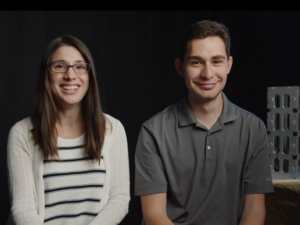This is a First Look: It's the first time any news outlet or blog has covered this startup. You can read more First Looks here. (We do this a lot.)
Even top performing professional athletes can develop bad habits that take a toll on their bodies. From poor form to general muscular imbalances, there are certain factors that can make people more susceptible to being hurt - or prevent them from bouncing back from an injury.
You could be having issues with your knee that’s actually a result of limited motion in your hip. But your physical therapist might not even know that just by looking at you.
That’s why EuMotus, a startup with Harvard ties, came to be. Henry Liu and Casey Di Cesare, two former college athletes who founded EuMotus, have developed a solution that lets physical therapists pinpoint and track all of the underlying problem areas contributing to a patient’s injury.
Using tech for better PT
With EuMotus, Liu and Di Cesare are letting PT professionals monitor and map a person’s movements in 3D. Unlike other products of the past, this startup’s technology employs a camera with infrared sensors, which means patients don’t need to be decked out in electrodes or markers.
“Patients are asked to do a series of functional motions like overhead squats and shoulder range exercises,” Liu said. “The camera tracks every movement and assess how they’re being completed.”
“Overhead squats, for example, can show physical therapists motion in a patient’s knees and hips, but also in their neck and shoulders,” he explained further. “They can determine, ‘Is there a tilt? Is their head craning forward? What is the knee flexion like? Does it have full range of motion? If not, what’s preventing it?’”
The more functional motion exercises that patients do in front of EuMotus’ camera, the better PT professionals can identify different muscular imbalances and infer what’s causing those imbalances. That’s because the more data that the solution’s algorithms have to work with, the more precise EuMotus can be.
At the moment, EuMotus is being tested by a select group of physical therapists, keeping everything going from the funds they won last spring at Harvard's Dean's Challenge and from bootstrapping. Once the team adds some other features and irons out any kinks with their current product - probably early next year - it will be available to all PT professionals.
"We are looking to use a subscription model, charging physical therapies a monthly fee," Liu said. "In return, we provide the hardware required and our software as well as periodic updates to features and our algorithms."
Helping athletes stick to the program
Both Liu and Di Cesare, who met playing soccer in middle school, have past athletic experiences that act as inspiration for their startup. Di Cesare competed in track and field at UCLA and is now a specialist within the PT realm. At the same time, Liu was the captain of the fencing team at Brown, where he studied Applied Mathematics (hence the impressive algorithm component of EuMotus).
“Fencing is a sport full of asymmetrical movements,” Liu told me. “I was frequently injured - my left ankle, my left knee, my right hip - and I’d have to continuously go to the trainer, go in for rehab.”
Liu, like many athletes, was so bent on getting off the bench that he was quick to quit his PT as soon as he started to feel on the mend. By bailing early on a rehab program, Liu was never able to address the root of his injuries, which only set him up for getting more hurt in the future.
“After going in 6 or 7 times, I’d feel better,” he confessed. “And being an athlete with that driven mentality, I’d stop the rehab program and go back to competing. I would always be injured again shortly after going back before I was supposed to.”
By using EuMotus, physical therapists will be able to develop programs better catered to a given person’s injuries. They’ll also be equipped to track how a patient is progressing with data about his or her motions. Hopefully, having tangible information about the status of an injury will prevent antsy people from ducking out of PT before they’re ready.
“It allows physical therapists to focus on the true cause of an injury, but it also helps them engage their patients,” Liu began. “It gives them something to show patients, so the patients know their progress. I couldn’t see that my ankle flexion wasn’t where it was supposed to be; it felt better to me, so I thought it was better.”
“Now, physical therapists can actually show patients that they’re on their way to becoming better, but they’re still not at the range they should be,” he went on. “This will hopefully increase patient understanding and retention. They’ll be more likely to continue a program knowing what they’ve achieved and the progress they still have to make.”
Images via Henry Liu.








